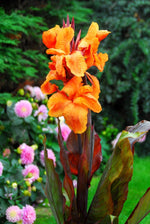
Wyoming
499
About Wyoming
Introducing the Canna Wyoming! Add a touch of tropical paradise to your garden with these stunning blooms! Wyoming is a strong-growing plant that can reach up to 3 ft. tall.
- Large, vibrant orange flowers with bronze-purple leaves
- Easy to care for and maintain
- Perfect for adding height and drama to your garden beds or patio containers
- Can be planted in full sun or partial shade
- Very large flowers
- Blooms from mid/summer to early fall
How to care for Wyoming
- Simply dig a hole that is twice the size of the root ball and place the plant in the hole.
- Backfill with soil and water well.
- Canna Wyoming prefers well-drained soil and regular watering.
- Fertilize with a balanced fertilizer every 4-6 weeks during the growing season.
- Deadhead spent blooms to encourage continued blooming.
FAQs

